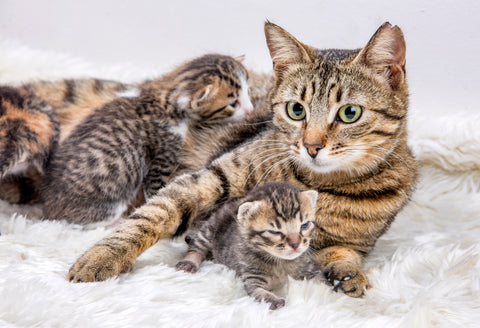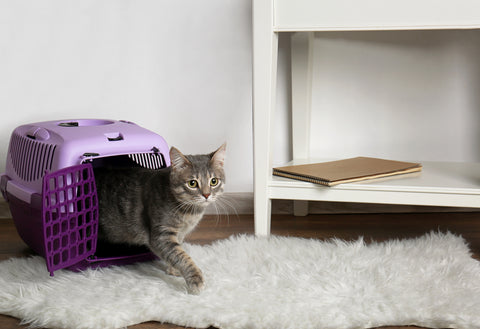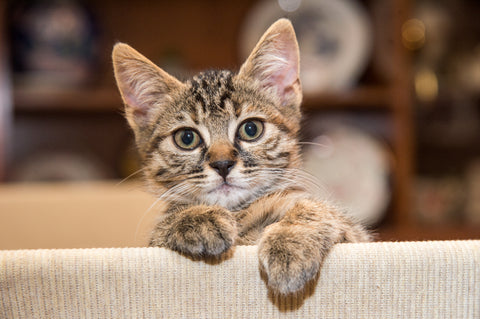
How to Raise a Healthy Kitten
There’s nothing cuter than a happy, healthy kitten. But there’s more to bringing up your ball of mischief than first meets the eye. Here’s our guide on how to raise a happy, healthy kitten.
You need to give plenty of careful guidance as well as lots of toy mice on their journey from playful kitten to well-adjusted feline companion. Here’s how it’s done, from kittens under 8 weeks through to teenagers and adult cats.
Kittens under 8 weeks old: With Mum
Kittens under 8 weeks old are too young to leave their mum. They can’t yet regulate their own body temperature – so need to snuggle with their littermates – and are still developing vision and leg coordination. Mum will feed kittens every 2 hours or more and will help them defecate and keep the nest clean. It is possible to safely bottle rear much younger orphaned kittens, but you’ll need the advice and support of a vet, rescue or vet nurse.

Give your new cat or kitten time and space when first arriving home.
Did you know? Like puppies, kittens have a ‘socialisation period’ where they’re most receptive to new experiences. This peaks between the age of 2-8 weeks, so ask the rescue or breeder about how they have socialised your new baby. You can continue socialisation at home, but these early days are really important.
Kittens at 8-10 weeks old: Weaning
Mum stops feeding kittens milk at around 8 weeks, and the little ones start to eat ‘real food’. At this stage, kittens use lots of energy, so provide proper kitten food that’s designed to be digestible, energy dense and rich in protein.
They develop their complex motor skills too; running, jumping, climbing and playing. Kittens love to explore at this stage and will be ‘getting into everything’!
This is the time when you’re likely to bring your kitten home, but before you do there are a few things you can do to get prepared.
Before you bring your kitten home
It’s important to prepare properly before you bring a kitten – or cat – home for the first time. It’s a good idea to confine your kitten to a single room to start off with so they don’t become overwhelmed, and it’s easier to kitten-proof that way. You’ll need to remove breakables like small ornaments and be realistic about accidents and scratching. Your baby cat won’t get everything right first time, so your posh front room might not be the best choice! Kitchens aren’t ideal either, as there are lots of potential hazards, comings and goings. A quiet bedroom or family sitting room is a good bet. Shut all windows, and block off any nooks, crannies or ways to escape to the outside world. Kittens are very curious and can get in tiny spaces!
Before you bring your kitten home, set up their room. Put their bed somewhere quiet and off the ground. Place a litter tray in a corner and set up a feeding area in the opposite corner – cats won’t toilet and eat in the same area. Pop the water bowl somewhere high but accessible, away from the feeding area. Some toys and a hot water bottle under the kitten’s bed will make things more homely too.
The big day has arrived and it’s time to collect your kitten – or kittens! It‘s worth investing in a secure carrier as there’ll be trips to the vets to come. Ask the rescue or breeder if you can borrow a blanket that smells of home and Mum with you. Pop it in the carrier with your kitten or kittens, then very carefully take your new little ones home. Drive slowly and steadily, or get a taxi rather than a bus – make the experience as relaxed as possible.
Arriving home for the first time
Take your kitten’s carrier to ‘their’ room and open the cage door. Pop some tempting treats outside, then let your kitten explore at their own pace. Don’t pull them out of the carrier, and make sure family children keep back and quiet so as not to overwhelm the kitten. Always supervise interaction between children and animals.
Top tip: it’s a good idea to have a ‘one hand only’ rule with children and pets, so little ones don’t hug, squeeze, hurt or overwhelm animals. Accidents can happen, and both cats and dogs will use teeth and claws defend themselves if scared or hurt.

Give your new cat or kitten time and space when first arriving home.
Feeding your kitten
It’s not a good idea to switch your kitten’s food when they first arrive home. We’d recommend stocking up on the kitten food the rescue or breeder weaned your kitten on and continuing with that. The stress of a new home plus a change in food may bring on a wobbly tum. It might be sensible to have some YuDIGEST Plus handy just in case. If you want to change your kitten’s diet, do so gradually over a couple of weeks, and always feed the best quality kitten food you can afford. Adults have different nutrition requirements to kittens, who burn lots of energy and need lots of fuel as they grow.
Litter trays and litter training
Kittens are naturally clean, and most are toilet trained by their mums before they leave their first home. When you buy a litter tray, make sure it’s a decent size – big enough for an adult cat to turn in – and ask the breeder or rescue what kind of litter the kitten is used to. This will reduce any accidents. Many kittens and cats prefer covered trays for a bit of privacy and remember to never disturb a cat or kitten when they’re toileting. This RSPCA article has more litter training tips.
Top tip: pick up and flush poos straight away and change litter regularly – cats and kittens won’t use dirty trays. When you change the litter, add a little of the old back in so your kitten knows where to ‘go’.
Happy, healthy kitten checklist:
- Choose your vet and book a vaccination appointment.
- Find out what food your kitten is accustomed to and stock up – buy treats, too. Go shopping for kitten essentials: a snuggly nest, a litter tray (and litter), kitten-sized toys, food and water dishes.
- A scratching post is a good idea too. Kitten proof your home – remove breakables and close windows.
- Prepare your family – talk to children about how to carefully and kindly handle animals.
Kittens at 10 weeks to 4 months: Growing fast
Your kitten is now the equivalent of a primary school child: they’re growing and learning fast. They’ll burn lots of energy – 3x as much as an adult cat – so they need lots of fuel. Keep up the high-quality kitten diet, and feed them regularly, between 3-5 times a day (follow the instructions on the pack). Though they may look like a small cat now, remember that your kitten is still a baby really, and needs careful handling, guidance and continued socialisation to become a well-adjusted adult.

Your kitten will be extra playful at this age!
Top tip: be sure to visit the vet for a check-up and to vaccinate your kitten as soon as you can. Don’t let them outside until they have built up immunity, usually at around 14 weeks.
Kittens and the great outdoors
If your kitten is a future outdoor cat, you’ll need to keep them indoors until their vaccinations have taken and they have built immunity to infectious diseases. This is usually around the age of 14 weeks but check with your vet for advice.
We’d advise supervised garden play only until your cat has been neutered, and perhaps training your kitten with a harness and lead. This can be helpful in later life you plan to travel with your cat. There’s a good guide to leash training on Dr Mercola – it’s more common to see people ‘walking the cat’ in the US!
Ongoing socialisation and training your kitten
Did you know that it’s possible to train cats as well as dogs? Of course, some individuals are more receptive than others, but it’s a good idea to get your kitten used to gentle handling, tooth brushing, claw trimming and going in their travel box. Make every experience positive, with lots of treats and games.
Help your kitten become accustomed to being handled by different people and being touched in different places – tummy, ears, paws. Encourage your kitten to be outgoing by letting them experience different people, animals, sights and sounds. By combining lots of different situations with positive reinforcement and rewards, you increase the chances of your kitten growing into a happy, confident, well-adjusted cat.
Want to take things further? It’s possible to train cats to play fetch and even perform tricks using positive reinforcement methods like clicker training – there’s a good basic guide here. Your kitten’s personality, IQ and food motivation levels will play a part in what’s achievable, but it’s all good bonding fun!
Adolescent cats at 4-6 months: Sexual maturity
This is your kitten’s teenage time, and the top priority here is neutering. Adolescent kittens aren’t adult cats, and though they can physically reproduce, it’s not a good idea. Sexual maturity brings with it new behaviours including straying, territorial ‘spraying’ (weeing in the house to mark territory) and ‘calling’ (where a female mews loudly to attract a mate). Many vets neuter before 4 months to avoid these behaviours, so talk about this when you take your kitten in for their vaccinations. Your rescue or breeder will be able to provide advice, and the Cats Protection League has a good leaflet here.
18 months: Adulthood
Kittens don’t become adult cats until around 18 months, so you may notice the dynamic of your household changing up until this point. If you have multiple cats, make sure you provide enough hidey spots, toys or food so there’s no need to fight. If you adopted 2 kittens, you may find they become less attached as they reach maturity. It’s perfectly natural: they’re just growing up.
Kitten FAQs
While adopting a new kitten is undoubtedly exciting, you’re likely to have a few questions. Here are the answers to just a few of the common ones.
Where’s the best place to find a kitten?
It’s best to go to a good rescue or a Governing Council of the Cat Fancy (GCCF) registered breeder. Though many kittens are sold online or through papers or even notices in the newsagent, these kittens may not be the best choice. Rescues and registered breeders have lots of experience, so will have properly cared for both Mum and babies. Some unscrupulous kitten sellers are more interested in extra cash than healthy cats, and kittens may be unhealthy, inbred or not properly socialised, which can lead to big problems further down the line.
Should I adopt one kitten or two?
Many rescues and breeders will only re-home kittens in pairs, while some cats live happily with just their owners for company. This, to a degree, depends on whether you’re going to be at home a lot, and the breed and personality of the feline friend in question. Some breeds, such as Bengal cats, can be quite dominant and territorial, and may be happiest with all your attention. Talk to your rescue or breeder and take their advice.
What if my kitten bites or scratches?
Most kittens play with their claws and teeth, but you shouldn’t encourage this behaviour. If the scratch or bite, say ‘no’ firmly and stop the game. Most soon learn that biting and scratching means the end of the fun and modify their behaviour.
If your kitten is very focused on attacking hands and feet, you can also ‘play dead’. Instead of reacting to pounces and play, remain still and quiet until your kitten stops. Then start a game with suitable toy and give your kitten lots of praise. This teaches your kitten that bits of people are boring, and toys are more fun!
Can you safely introduce a kitten to other pets?
In a word, yes. It takes time and patience, but kittens can be introduced to other cats and dogs who are cat-safe – there’s good guidance in this Cats Protection League leaflet. We know of a few kittens who’ve grown up alongside all kinds of other species, becoming besties with natural prey creatures like rats and birds!
How else can I support my cat’s development?
Start your kitten off on the right paw with a good healthcare regime. We recommend setting calendar updates on your phone or computer to provide a reminder when it’s time for flea treatment, worming and booster vaccinations, and staying with a vet practice who’ll get to know your cat.
Once your kitten has grown up a little, you might also consider supplementing your her diet to keep her in purrfect shape. YuMOVE Cat is great for mobility and joints support, while YuDERM Cat keeps your cat’s skin and coat in tip-top condition. If your cat starts to display any signs of anxiety, YuCALM Cat can help her to cope with stress and be happier and calmer.
We hope you’ve found our happy, healthy kitten guide useful, and we would love to meet your cats and kittens on Facebook, Instagram and Twitter. If you’ve got kitten pics and videos to share, you’ll make our day!





